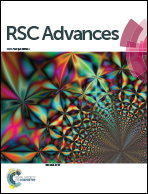Fostering protein–calixarene interactions: from molecular recognition to sensing†
Abstract
Two isomeric bis-calixarene-carbazole conjugates (CCC-1 and CCC-2) endowed with carboxylic acid functions at their lower rims have been found to display a high sensing ability (KSV up to 6 × 107 M−1) and selectivity toward cytochrome c, a multi-functional protein, in an aqueous-based medium. After targeting basic amino acid residues on the protein surface residing near the prosthetic heme group through electrostatic and hydrophobic interactions, a rapid photoinduced electron transfer ensues between the integrated transduction element (aryleneethynylene chromophore) of CCCs and the iron-oxidized heme of cytochrome c, enabling direct detection of the protein at nanomolar levels. Our results show that CCCs are capable of efficiently discriminating heme proteins (cytochrome c vs. myoglobin) and non-heme proteins (lysozyme) in an aqueous medium. Studies performed in two solvent systems (organic and aqueous) strongly suggest that in an organic medium a Förster-type resonance energy transfer is responsible for the observed reduction in CCCs emission upon contact with heme proteins while in an aqueous medium a specific photoinduced electron transfer mechanism prevails.


 Please wait while we load your content...
Please wait while we load your content...